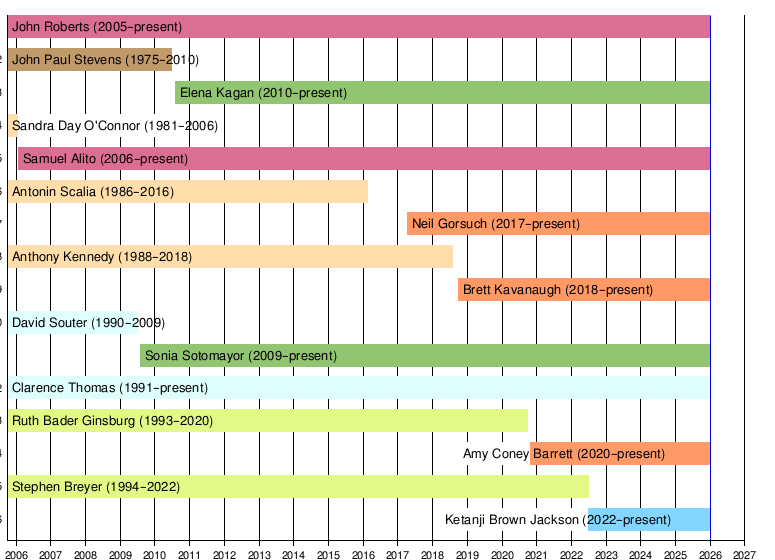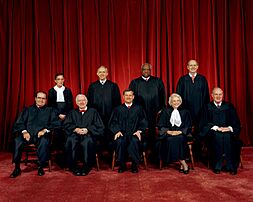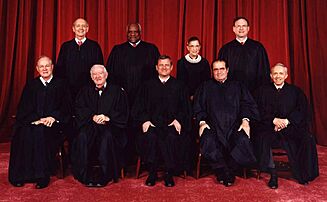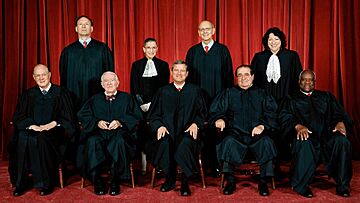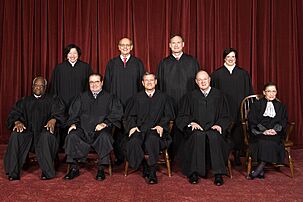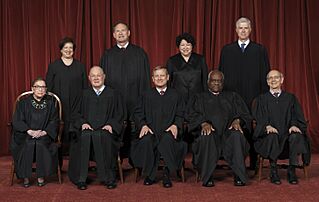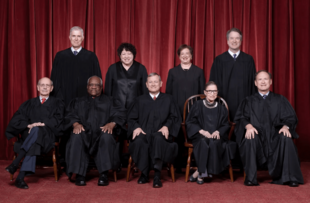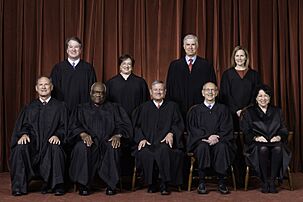Roberts Court facts for kids
| Roberts Court | |
|---|---|
|
Rehnquist Court ←
→ Current
|
|
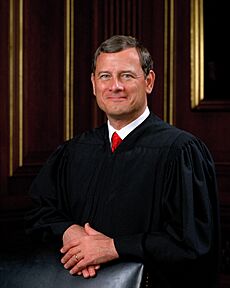
|
|
| September 29, 2005 – 20 years, 81 days |
|
| Seat | Supreme Court Building Washington, D.C. |
| No. of positions | 9 |
| Roberts Court decisions | |
 |
|
The Roberts Court is the name for the period since 2005 when the Supreme Court of the United States has been led by John Roberts. He serves as the Chief Justice. Chief Justice Roberts took over after the death of the previous Chief Justice, William Rehnquist.
Many people see the Roberts Court as one of the more conservative courts in recent history. This is partly because Justice Sandra Day O'Connor, who was more moderate, retired. She was replaced by Justice Samuel Alito, who is seen as more conservative. Later, Justice Anthony Kennedy, who often voted in the middle, was replaced by Brett Kavanaugh in 2018. Then, in 2020, Justice Ruth Bader Ginsburg, who was known for her liberal views, was replaced by Amy Coney Barrett.
Since Justice Barrett joined, the Roberts Court has become less popular with the public. This is based on surveys by Gallup, which started polling about the Court in 1973.
Contents
Who are the Justices?
When John Roberts was first chosen by President George W. Bush, it was to be an associate justice. He was meant to replace Justice Sandra Day O'Connor, who planned to retire. However, before the Senate could vote on Roberts for that role, Chief Justice William Rehnquist passed away.
President Bush then changed his mind. He asked the Senate to consider Roberts for the top job: Chief Justice. The Senate agreed, and Roberts was confirmed on September 29, 2005, with a vote of 78 to 22. On the same day, he took his oath of office at the White House. The oldest associate justice at the time, John Paul Stevens, gave him the oath.
The Roberts Court officially began with Chief Justice Roberts and the eight associate justices who were already serving from the Rehnquist Court. These were Justices Stevens, O'Connor, Antonin Scalia, Anthony Kennedy, David Souter, Clarence Thomas, Ruth Bader Ginsburg, and Stephen Breyer.
President Bush then needed to find someone to replace Justice O'Connor. His first choice, Harriet Miers, decided not to go forward. His next choice, Samuel Alito, was confirmed in January 2006.
Over the years, other justices have retired or passed away, and new ones have joined.
- In 2009, President Barack Obama chose Sonia Sotomayor to replace Justice Souter. She was confirmed.
- In 2010, President Obama chose Elena Kagan to replace Justice Stevens. She was also confirmed.
- In February 2016, Justice Scalia died. President Obama nominated Merrick Garland, but the Senate did not vote on him.
- In January 2017, President Donald Trump nominated Neil Gorsuch to replace Scalia. After some debate in the Senate, Gorsuch was confirmed in April 2017.
- In 2018, President Trump nominated Brett Kavanaugh to replace Justice Kennedy. He was confirmed.
- In September 2020, Justice Ginsburg died. President Trump nominated Amy Coney Barrett to take her place. She was confirmed quickly, in October 2020.
- In 2022, Justice Breyer announced he would retire. President Joe Biden nominated Ketanji Brown Jackson to replace him. She was confirmed by the Senate. Justice Jackson became the first Black woman and the first former public defender to serve on the Supreme Court.
A Look at the Timeline
How the Court Works with Other Government Parts
During the time of the Roberts Court, four different presidents have been in office. These are George W. Bush, Barack Obama, Donald Trump, and Joe Biden.
Also, many different groups of Congress have been working. These include the 109th Congress all the way up to the current 118th United States Congress. The Supreme Court works alongside these other parts of the government.
Important Decisions by the Court
The Roberts Court has made many important decisions on a variety of topics. These rulings affect laws across the United States. They have covered areas like gun control, rules about affirmative action (which aims to help groups that have been discriminated against), and how political campaigns can be funded.
They have also made decisions about election laws, capital punishment (the death penalty), and LGBT rights. Other important topics include rules about unlawful search and seizure by police and how people are sentenced for crimes.
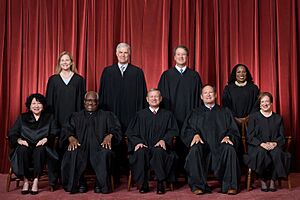
Some of the major decisions made by the Roberts Court include:
- Massachusetts v. EPA (2007)
- Medellín v. Texas (2008)
- District of Columbia v. Heller (2008)
- Kennedy v. Louisiana (2008)
- Ashcroft v. Iqbal (2009)
- Citizens United v. Federal Election Commission (2010)
- National Federation of Independent Business v. Sebelius (2012)
- Arizona v. United States (2012)
- Shelby County v. Holder (2013)
- Burwell v. Hobby Lobby (2014)
- Riley v. California (2014)
- Obergefell v. Hodges (2015)
- Whole Woman's Health v. Hellerstedt (2016)
- Trump v. Hawaii (2018)
- Janus v. AFSCME (2018)
- Timbs v. Indiana (2019)
- Rucho v. Common Cause (2019)
- Bostock v. Clayton County (2020)
- Espinoza v. Montana Department of Revenue (2020)
- Dobbs v. Jackson Women's Health Organization (2022)
- Kennedy v. Bremerton School District (2022)
- Moore v. Harper (2023)
- Students for Fair Admissions v. Harvard & Students for Fair Admissions v. University of North Carolina (2023)
- 303 Creative LLC v. Elenis (2023)
- Trump v. Anderson (2024)
- Loper Bright Enterprises v. Raimondo (2024)
- Trump v. United States (2024)
Gallery


